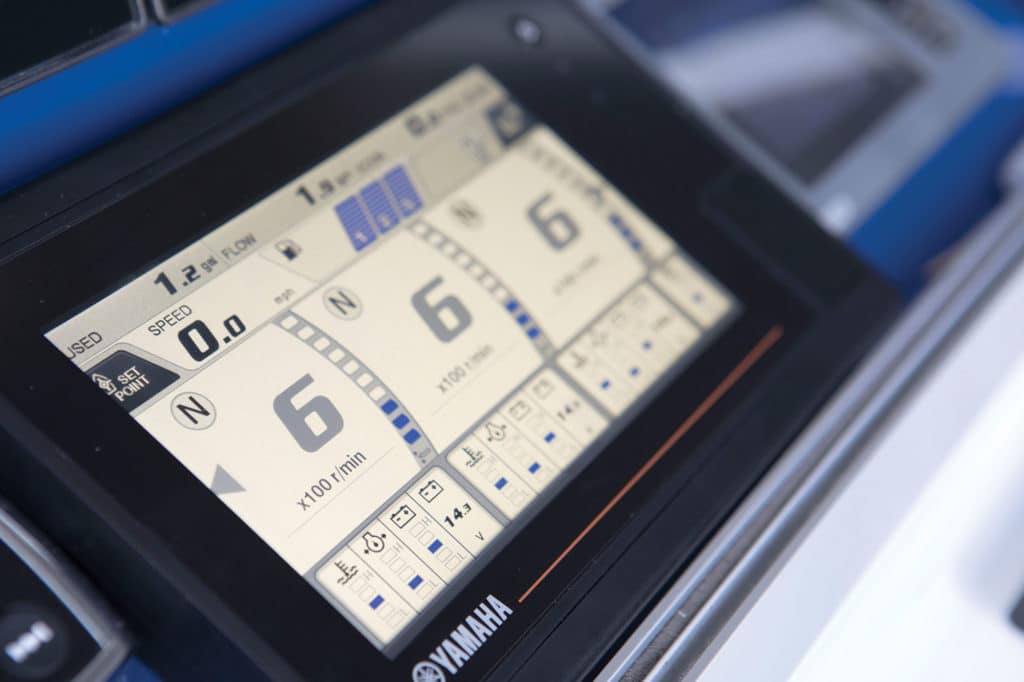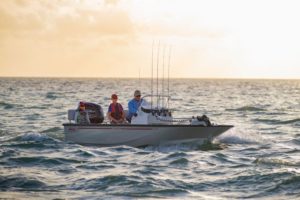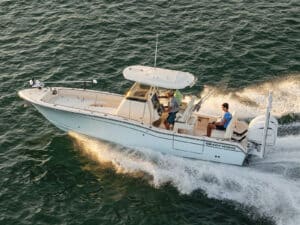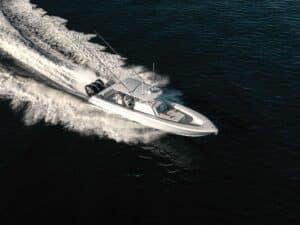
The information revolution has permeated every aspect of our lives, including our time on the water. “Boaters are looking for as much information as possible,” says David Meeler, manager of product planning and information for Yamaha Outboards.
In order to meet growing expectations, outboard-engine brands such as Evinrude, Honda, Mercury, Suzuki and Yamaha have developed color touchscreen displays that take the place of push-button digital displays and conventional analog gauges on boat helms.
These multifunction displays (MFDs) are becoming prevalent aboard center-console fishing machines in excess of 30 feet LOA. While non-touchscreen digital and old-school analog gauges still occupy helms on many new boats—particularly smaller craft such as flats skiffs—engine MFDs represent the future.
Versatile View
The user interface results in great versatility. With the new Suzuki Multi-Function Display (SMD) series (available in 7-, 9-, 12- and 16-inch screens), for example, the captain can customize screens with combinations of engine and systems data. Available engine data includes rpm, speed, fuel consumption, fuel level, mpg, alternator output, battery voltage, engine temp, trim angle, engine hours and more. Displays from Suzuki and others will also show maintenance reminders, system warnings, and diagnostics.
Suzuki’s MFDs, built by Furuno, can also serve as chart plotters, and the two larger displays will integrate with compatible chirp sonar and radar modules. An internal Wi-Fi internet connection lets you tap into weather information.
Yamaha’s CL7, a 7-inch engine display built in partnership with Garmin, provides a built-in plotter and full networking capabilities with Garmin displays. Mercury Marine’s VesselView 703 and 903 (7- and 9-inch displays, built in partnership with Navico, makers of Simrad and Lowrance brand electronics) feature built-in sonar systems and plotters, plus networking capabilities with compatible Simrad MFDs.
Unlike analog gauges, most engine MFDs can be updated by the boat owner with software upgrades to offer new and improved features.
Less Clutter
With large center-console fishing boats now sporting three, four or more outboards, engine MFDs reduce clutter and wiring at the helm. A digital network serving a single touchscreen can cover multiple engines.
Yamaha’s CL7, for instance, can connect to as many as three engines to show complete data for each in one place, Meeler says. Mercury goes even further. “You can have as many as six outboards on a Mercury VesselView 502, 703 or 903 multifunction display,” says Walter Ross, Merc’s senior product manager for controls and rigging.
Integration and Control
Engine MFDs can also control certain engine-related functions via touchscreen buttons. “For example, the CL7 MFD can activate Set Point functions for Yamaha’s Helm Master boat-control system,” Meeler points out. You can engage and disengage Stay Point, Fish Point and Drift Point with the CL7, he says.
In another example, with Mercury VesselView 903, 703 and 502 MFDs, you can also control marine accessories and systems on boats equipped with C-Zone or Naviop digital switching, provided that the VesselView display is integrated with a Simrad MFD and interfaced with the digital-switching system.
As indicated earlier, these engine displays can also share information across a network to show the same data on other MFDs. With Mercury’s proprietary SmartCraft operating system and a VesselView Link black-box module, full data and touchscreen controls can be shared and displayed on a compatible Simrad MFD. Similarly, Yamaha CL7 can share full engine data and controls with compatible Garmin MFDs, though no additional black-box module is necessary.
MFD Direct
With some Mercury and Yamaha propulsion systems, you can forego an engine manufacturer’s display to access data. Digital engine information can be routed to, selected and viewed on a boat’s larger second-party MFD. With Mercury, only the Vessel View Link module is required to do this on Simrad MFDs.
With Yamaha, an analog-gauge interface is needed if you choose to eliminate a factory MFD and use a Garmin display instead. The new Yamaha 425 XTO outboard is an exception: It requires the Yamaha CL7 MFD for proper setup of the motor’s integral electric steering.
In addition, to grant certain controls, such as Mercury’s Joystick Piloting or to integrate Yamaha’s Helm Master system features, a dedicated MFD from the respective engine company is necessary.
Wireless Wonders
Let’s say you own a boat equipped with analog gauges, but you want the capability of viewing the rich amount of information available on an engine MFD. If the boat sports a recently built Mercury engine of 40 hp or above, you’re in luck. By adding a compact VesselView Mobile module (about $225) to the engine and downloading the free VesselView Mobile app, your tablet or smartphone becomes a de facto engine MFD.
VesselView Mobile (for iOS and Android) lets you access and read engine data on your mobile device. Robust marine mounting systems from companies such as Ram Mounts can secure a mobile device at the helm. Like an engine MFD, VesselView Mobile will also display maintenance reminders, engine alerts and diagnostics.
Read Next: Electronic Throttle Versus Cable Throttle: Making the Switch
Suzuki’s SMD series also offers a wireless function, one focused on usage history and diagnostics. With the free Suzuki Diagnostic System (SDS) mobile app, available for iOS and Android, you can use your smartphone to scan QR codes from an SMD to instantly upload data, including the number of engines, number of hours since the last oil change, total engine hours and hours of operation at different rpm. You can then review engine usage from past trips on your phone or even email the data from the app to a Suzuki dealer for diagnostic purposes.
Cost-Benefit
The biggest downside of touchscreen engine MFDs is the higher cost versus analog gauges or even digital nontouchscreen gauges. Mercury’s VesselView 703 and 903, for instance, carry MSRPs of more than $2,000. The same applies to a Yamaha CL7.
Compare these prices with those of analog gauges retailing from less than $300 for a complement of five, or even to a Mercury SmartCraft or a Yamaha multifunction digital gauge retailing between $300 and $400 each.
The cost difference is striking, but so are the additional benefits of engine touchscreen MFDs. As the information revolution advances, it’s good to know that engine data systems and displays are keeping pace.








